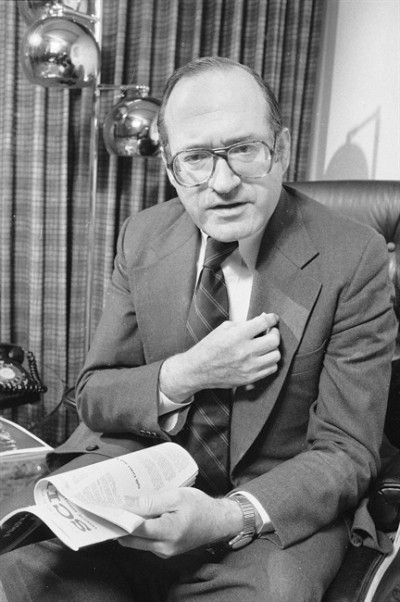Ernest Sternglass (Ernest Joachim Sternglass)

Both of his parents were physicians. When Ernest was fourteen, the Sternglass family left Germany in 1938 to avoid the fascist regime. He completed high school at the age of sixteen, then entered Cornell, registering for an engineering program. Financial difficulties encountered by his family forced him to leave school for a year. By the time he returned to Cornell, the U.S. had entered World War II. Sternglass volunteered for the navy. He was about to ship out when the atomic bomb was detonated over Hiroshima. After the war Sternglass married. In Washington, D.C. he worked as a civilian employee at the Naval Ordnance Laboratory, which researched military weapons. Sternglass began studying night vision devices, which led him to work with radiation. In 1947, his first son was born, and he had the opportunity to meet Albert Einstein.
From 1952 to 1967 Sternglass worked at the Westinghouse Research Laboratory. Early in his time at Westinghouse, he proposed a technology for image intensification. He also published a formula for interplanetary dust charging, which is still used extensively. All his work there involved nuclear instrumentation. At first he studied fluoroscopy, which “exposes an individual to a considerable dose of radiation.” Then he worked on a new kind of television tube for satellites. Eventually, he was put in charge of the Lunar Station program at Westinghouse. During his time at Westinghouse, he worked on a wide range of projects, including applying magnetohydrodynamics to gas-cooled reactor systems, and helping to develop the video cameras used in Project Apollo. In 1967, Sternglass moved to the Department of Radiology at the University of Pittsburgh School of Medicine, where he eventually was named professor emeritus. While there, through the early 1990s, he led pioneering work on the development of digital X-ray technology for medical imaging. Sternglass was director, co-founder, and chief technical officer of the Radiation and Public Health Project (RPHP). He died of heart failure on February 12, 2015, in Ithaca, New York.
In the early 1960s Sternglass became aware of the work of Alice Stewart. Stewart was head of the Department of Preventive Medicine of Oxford University, responsible for a pioneering study on the effects of low-level radiation in England. Stewart had discovered that a small amount of radiation to an unborn child could double the child’s chances for leukemia and cancer.
In the 1960s, Sternglass studied the effect of nuclear fallout on infants and children. He claimed not only an increase in leukemia and cancer, but a significant increase in infant mortality. In 1963 he published the paper “Cancer: Relation of Prenatal Radiation to Development of the Disease in Childhood” in the journal Science. In 1963, Sternglass testified before the congressional Joint Committee on Atomic Energy regarding the level of strontium-90 found in children as part of the Baby Tooth Survey. The result of bomb-test fallout, strontium-90, was associated with increased childhood leukemia. His studies played a role in the Partial Test Ban Treaty signed by President John F. Kennedy. In 1969, Sternglass reached the conclusion that 400,000 infants had died because of medical problems caused by fallout—-chiefly lowered resistance to disease and reductions in birth weight. In an article in Esquire, he claimed that the fallout from the nuclear explosions of an Anti-ballistic missile (ABM) system would kill all children in the U.S. (This claim was distorted by Dixy Lee Ray in 1989, asserting that Sternglass had said this of all nuclear weapons testing, in an op-ed in which she also dismissed anthropogenic global warming as “the current scare”. In 1979, Sternglass began extending his analyses of fallout effects to embrace behavioral disorders, including academic deficits seen in high school students. Later he was to blame radioactivity for higher crime rates and higher AIDS mortality.
In April 1979, Sternglass was invited to testify to Congressional hearings on the Three Mile Island accident. Two days later, when the hearings were moved from the House to the Senate, he was told his testimony was no longer desired. Sternglass believed that an effort was being made to suppress any evidence about possible deaths as a result of the accident. In a paper presented at an engineering and architecture congress, Sternglass argued that an excess of 430 infant deaths in the U.S. northeast that summer could largely be attributed to Three Mile Island radiation releases. This led some writers on environmental issues to claim that he had proven that figure as a minimum.
Sternglass also has written a book entitiled, Before the Big Bang: the Origins of the Universe, in which he offers an argument for the Lemaître theory of the primeval atom. He offers technical data showing the plausibility of an original super massive relativistic electron-positron pair. This particle contained the entire mass of the universe and through a series of 270 divisions created everything that now exists. If true, this would help ameliorate some of the problems with the current models, namely inflation and black hole singularities. E. J. Sternglass, Relativistic Electron-Pair Systems and the Structure of Neutral Mesons,Phys. Rev., 123, 391 (1961). E. J. Sternglass, A Model for the Early Universe and the Connection between Gravitation and the Quantum Nature of Matter, Lett. Nuovo Cimento, 41, 203 (1984).
Born
- September, 24, 1923
- Berlin, Germany
Died
- February, 12, 2015
- USA
- Ithica, New York
Cause of Death
- heart failure



